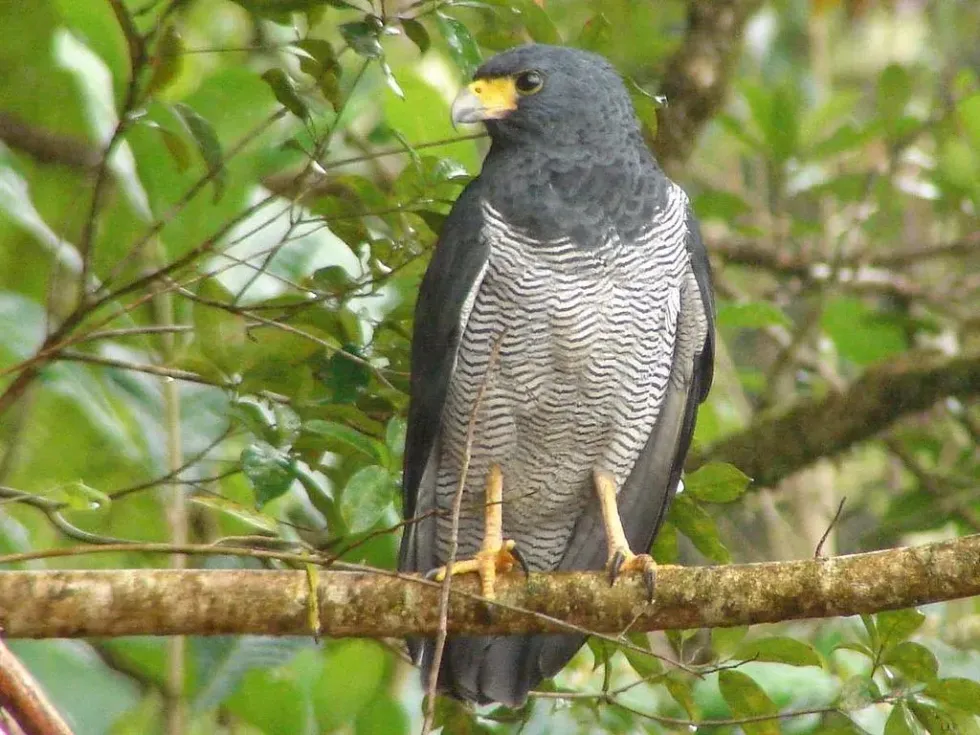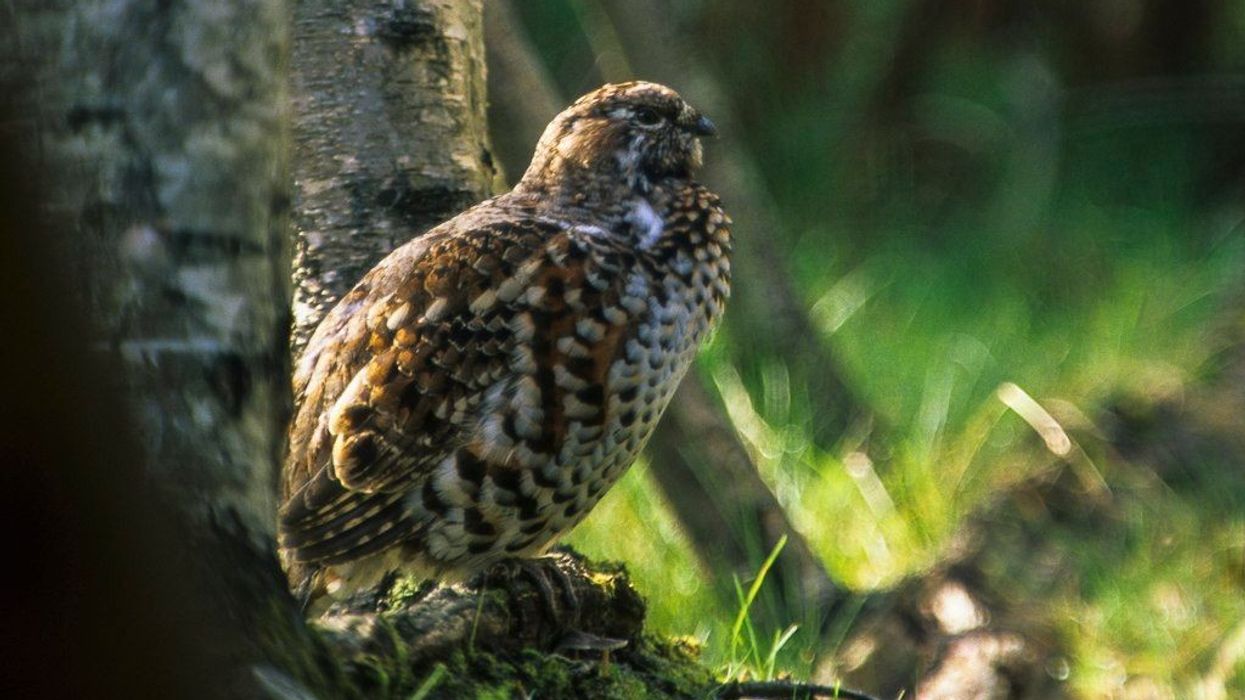There are close to 200 species of hawks in the world and the barred hawk (Morphnarchus princeps) is one from the same family and is seen throughout South America, Columbia, Costa Rica, Panama, and Peru. A barred hawk (Morphnarchus princeps) is a carnivore that feeds on chipmunks, frogs, voles, and lizards.
Juveniles too are fed the same. The barred hawk (Morphnarchus princeps) is classified as a Least Concern species by the IUCN. Barred hawk (Morphnarchus princeps) birds belong to the order Accipitriformes, family Accipitridae.
Barred hawks don't migrate and are sedentary birds. They are predatory birds and are mostly active at night. Barred hawks (Morphnarchus princeps) have loud calls and move easily through the forests they inhabit. Habitat destruction and deforestation are major threats to this species. Their populations are expected to face a decline in the upcoming years if deforestation continues.
For more relatable content, check out these fact files on red-backed shrike and griffon vulture.
Barred Hawk Interesting Facts
What type of animal is a barred hawk?
The barred hawk (Morphnarchus princeps) is a type of hawk, belonging to kingdom Animalia, order Accipitriformes, family Accipitridae.
What class of animal does a barred hawk belong to?
The barred hawk is a type of bird that belongs to the scientific classification class Aves, family Accipitridae, and genus Morphnarchus.
How many barred hawks are there in the world?
The population of barred hawks is estimated at less than 10,000 mature birds, and it is expected to decline further. Their distribution is scarce around the world. Since this species is non-migratory, their distribution is mainly seen in regions they are endemic to. A similar hawk species is seen in North America as well.
Where does a barred hawk live?
Barred hawks range in tropical to subtropical forest in regions in South America such as Columbia, Costa Rica, Panama, northern Ecuador, and Peru. This is where their distribution is mainly found. They are seldom seen in regions like North America.
What is a barred hawk's habitat?
A barred hawk's range occurs in tropical to subtropical forests and montane forest. They rarely occur in lowlands. They usually frequent between a canopy and a sub-canopy of a forest. They are seen at an elevation range of 2952.8-5249.3 ft (900 to 1600 m).
Who do barred hawks live with?
Barred hawks tend to be solitary birds, similar to other hawk birds. They come together for mating. This bird species coexists with other species in the wild. Hawks, in general, are addressed by their common name, hawk, since they appear more or less similar.
How long does a barred hawk live?
Barred hawks have a lifespan of 23 years in captivity and 10 or more years in the wild. A red-tailed hawk was 30 years old, the oldest hawk in the world.
How do they reproduce?
The nest is usually built by small branches and leaves. Post mating, the female lays one white egg per clutch. Incubation occurs slowly however, the duration is not known.
Post hatching, the chick is covered and leaves its nest after 80 days and depends on adults for food. Breeding occurs multiple times. The adults hunt for their young and they nest in the same site used the previous year.
What is their conservation status?
The barred hawk is not endangered, and their status is classified as a Least Concern species by the International Union For Conservation Of Nature IUCN Red List of Threatened Species.
Barred Hawk Fun Facts
What do barred hawks look like?
Identifying the barred hawk is simple. Barred hawks are medium-sized bulky raptors. They have black outer parts, however their belly is light in the pattern. They have a breast along with wing quills.
A barred hawk tail is short and they have broad rounded wings. These hawks have a barred tail and a white band on their underparts. They have dark brown eyes with a yellow-orange eyering.
Their bill is dark blue-gray to gray with a yellow-orange cere at the end of their head. Their face might resemble other hawks. Their legs are short and yellow-orange with black talons. Male and females are similar.
However, females tend to be darker in coloration and plumage compared to males and also differ in size. They might be confused with adult grey hawks which have a black and white striped tail, however they are different. Their wingspan is 48-48.8 in (122-124 cm).
* Please note, this is an image of a hawk, not a barred hawk specifically. If you have an image of a barred hawk, please let us know at hello@kidadl.com

How cute are they?
The barred hawk is not ideally cute, but they are exotic beings. Hawks and falcons are often confused with one another. Falcons are recognized by their long tapered wings and powerful hooked beaks. They have a breast along with wing quills.
Their wingspan is 48-48.8 in (122-124 cm). Falcons have a short rounded head, while a hawk has a sleek and pointed head. Apart from this, their wingspan is also different.
How do they communicate?
The barred tail hawk is a noisy bird. They are specifically noisy when they soar in small groups. The sound is a screening 'Kee-yaaaar' repeated once or several times followed by rapid 'wheep' notes. They also produce a series of loud whistles, 'Kwee-kwee...kweeaa...'.
How big is a barred hawk?
A male barred hawk is 13.7-14.4 in (347-367 mm) in length, and a female is 13.8-15.3 in (351-388 mm) in length. This is 10 times bigger than the smallest bird in the world, a bee hummingbird which is 2.2-2.4 in (5.5-6.1 cm).
How fast can a barred hawk fly?
The barred hawk's exact flying speed is not recorded. However, they are pretty fast in-flight using their broad wings and have sharp instincts. A hawk with a white barred tail spreads its tail out while flying.
Not all hawks are migratory and some fly from east to west. They are known to fly in groups of four to five birds. The fastest flying bird in the world is the peregrine falcon.
How much does a barred hawk weigh?
A barred hawk weighs 2.2 lb (1 kg). As a juvenile, they tend to be small in size however, as they grow, their weight increases. The heaviest bird in the world is an ostrich.
What are the male and female names of the species?
An adult male hawk is called a tercel, and an adult female barred hawk is called a hen. Males and females are different in coloration, with the female being darker compared to the male. Males and females also differ in length and reproductive functions.
What would you call a baby barred hawk?
A baby hawk with a white barred tail is called an eyas. A baby barred hawk is mostly brown and small in shape and size. They are also referred to as juveniles. The juvenile is dependent on its parents until its ready to fledge and becomes independent.
What do they eat?
The barred hawk is primarily a carnivore in behavior. They primarily feed on snakes, frogs, large insects, earthworms, hermit crabs, and occasionally small mammals and birds.
Are they poisonous?
No, these birds are not poisonous. They are known to kill smaller birds as prey and search for them, soaring noisily in behavior. Most raptors drop their prey in order to kill their prey. They do not harm humans.
Would they make a good pet?
No, these birds are ideally wild birds and are best observed in their natural habitat or in a specific center. They thrive best in their natural habitat.
If you are considering adopting birds, you should consider other sociable and friendly species and search in stores or online sites where they are available. It iss illegal to capture a hawk, alive or dead, without proper permits in certain states.
Did you know...
In ancient tribes in history, a hawk crossing one's path represented a warning or an omen and was specifically looked for during times of war.
Hawks are found on all sites and continents in the world except in Antarctica.
The special thing is most hawks pair for life, however, if one partner dies, the other finds a new mate.
They usually travel together in a group in forests. This includes species from the west to the east.
Are barred hawks endangered?
No, they are not endangered. Threats they face apart from predators include habitat loss and deforestation. The population is estimated at less than 10,000 mature birds in the world and it is expected to decline further in the upcoming years. Migration is seen in some hawks. However, there is no record of barred hawk migration.
How do you identify a barred hawk?
Barred hawks can be identified both by their calls as well as their appearance. They have black outer parts, however their belly is light in coloration.
A barred hawk bird tail is short and they have rounded broad wings. This hawk has a barred tail and a white band on its underparts. Females have an overall darker plumage compared to males.
They can be confused with similar species that might have similar plumage and patterns. They are endemic to Columbia and other regions.
They are often confused with the Cooper's hawk bird which is endemic to the eastern North American region and found in Canada, eastern Texas, California to southern Mexico. The Ferruginous hawk is the largest hawk in Texas and North America. Cooper's hawks are relatively smaller than birds from the east.
Here at Kidadl, we have carefully created lots of interesting family-friendly animal facts for everyone to discover! For more relatable content, check out these Hawaiian hawk facts and saker falcon facts for kids.
You can even occupy yourself at home by coloring in one of our free printable barred hawk coloring pages.









